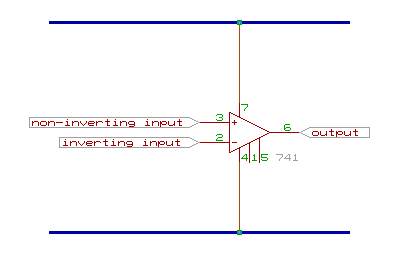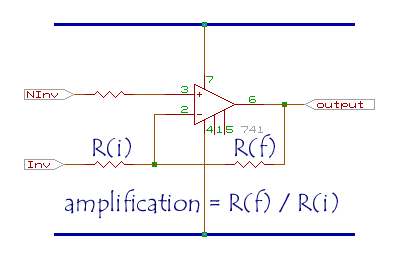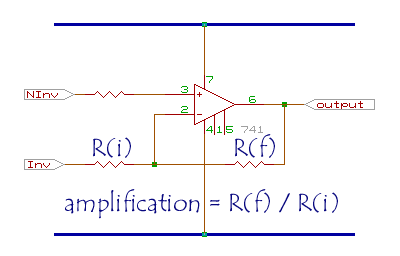-
Basic configuration of an operational amplifier represented by a "741" IC.
 Figure 5-1 Figure 5-1
- Amplification for an operational amplifier.
 Figure 5-2 Figure 5-2
-
The output of an operational amplifier reflects the difference in voltage between the inverting (Inv) and the non-inverting (NInv) inputs. A typical operational amplifier of the 741-type is able to amplify the voltage difference by about 200,000 times. This very high native amplification allows the user to control the behavior for a specific amplification by adding a "feedback resistance" R(f) in combination with an "input resistance" R(i) to provide specific amplification values from ZERO to its maximum.

-
case 1 - Inv input is at 0 (power supply is +12 volts and -12 volts)

-
case 2 - NInv input is at 0 (power supply is +12 volts and -12 volts)

Note that the negative sign is with respect to ZERO, thus a negative input at Inv will produce a positive output and a positive input will produce a negative output.
-
"ZERO" Offset. Remember that operational amplifiers produce a ZERO output whenever the voltage DIFFERENCE in their inputs is ZERO. There are applications, however, that require that the output be other than ZERO even if the difference in the inputs is 0. One solution would be to introduce offset voltages that will be added to or subtracted from the differences in the voltage levels of the inputs.
-
"SPAN" / Variable Amplification. The usual practice is to vary the ratio of R(f)/R(i) to produce a different amplification. Turning a potentiometer that varies either or both R(f) and R(i) is a usual semi-annual calibration requirement in "industry" applications.
-
"RANGE OF OUTPUTS" of OpAmps. Circuits using operational amplifiers similar to the 741, 301, etc., should be designed in such a way that the "maximum" and "minimum" output voltage range is at least 2.5 volts less than the positive supply voltage and 2.5 volts higher than the negative supply voltage.
|
|
 Figure 5-1
Figure 5-1
 Figure 5-2
Figure 5-2



